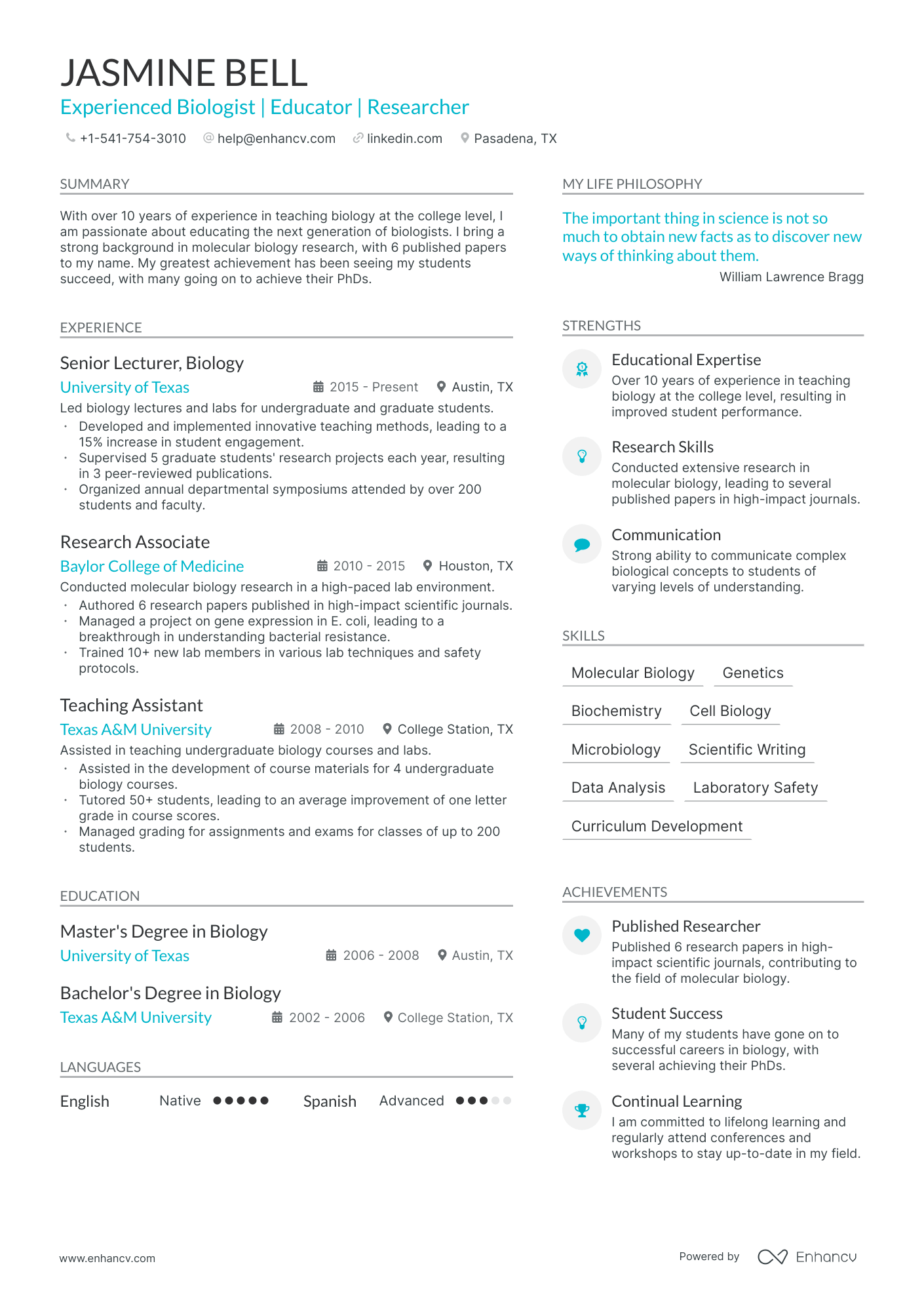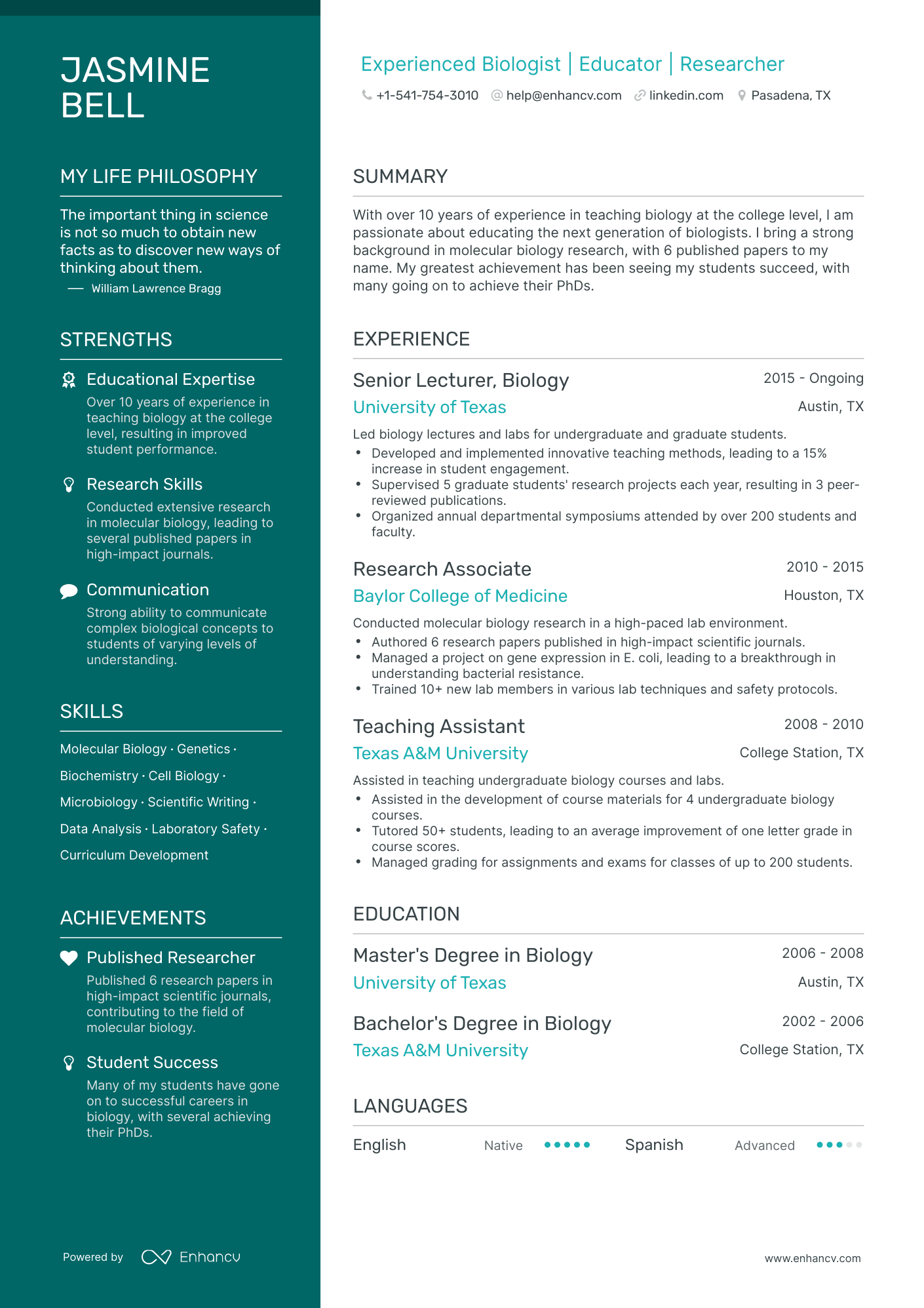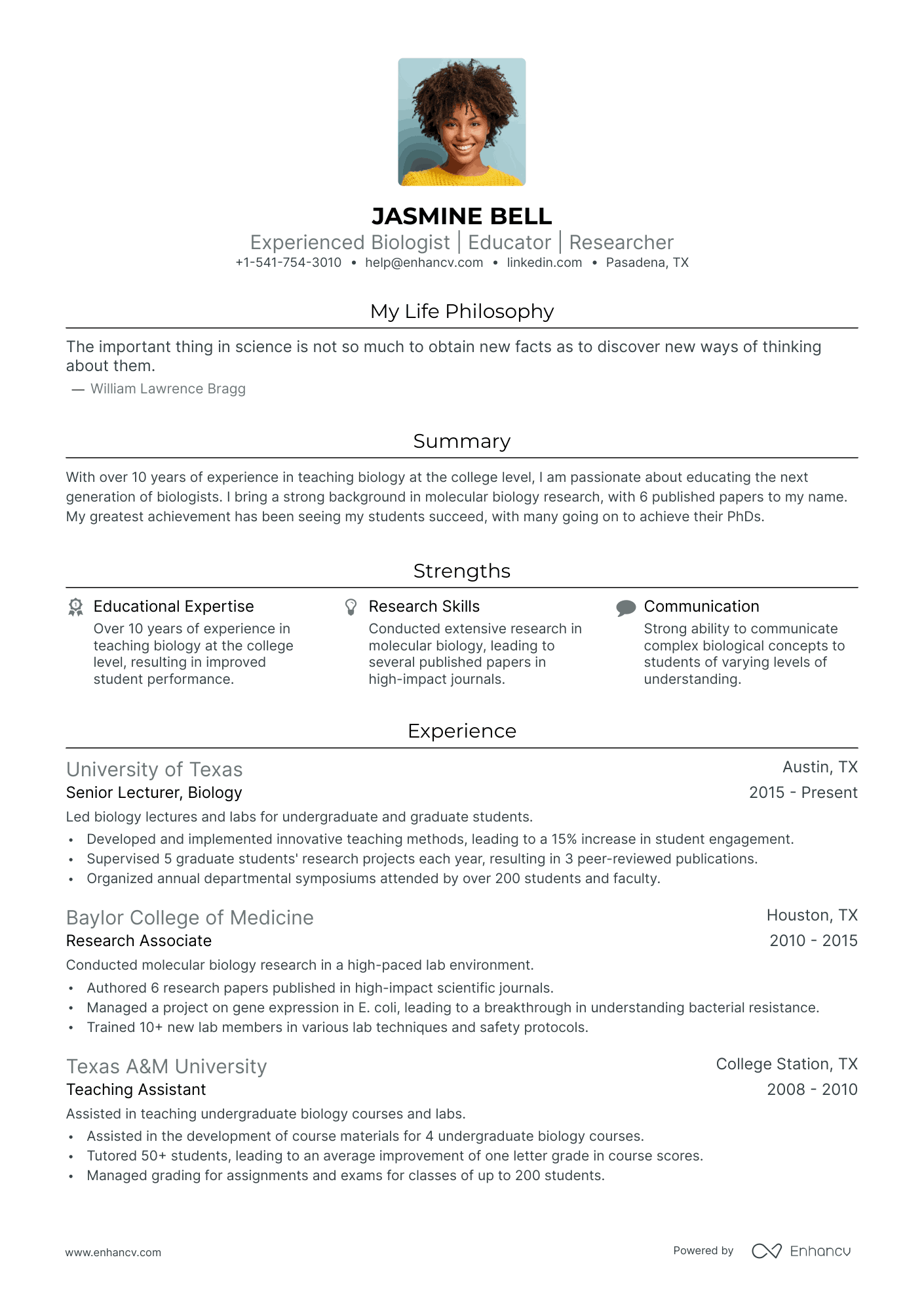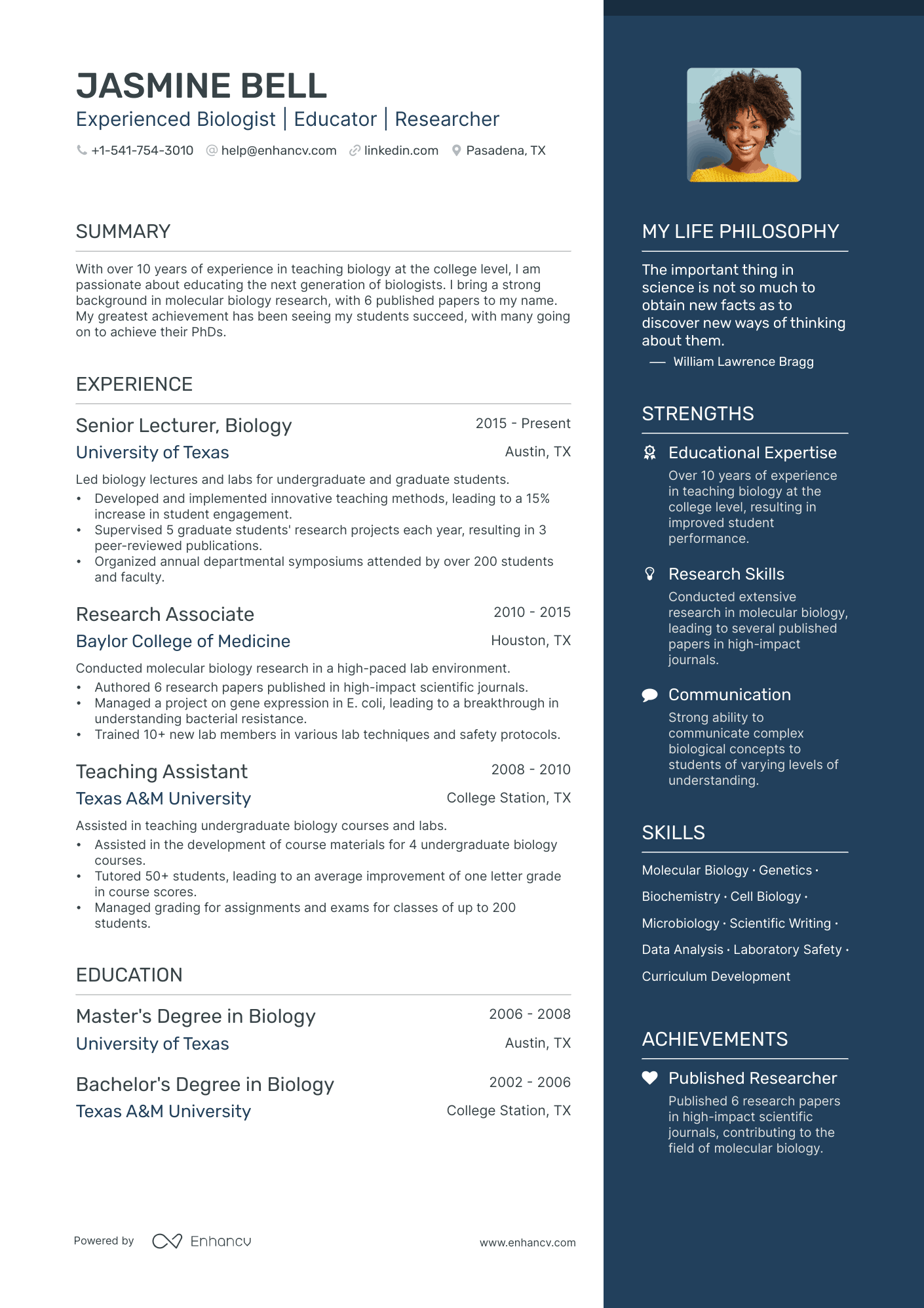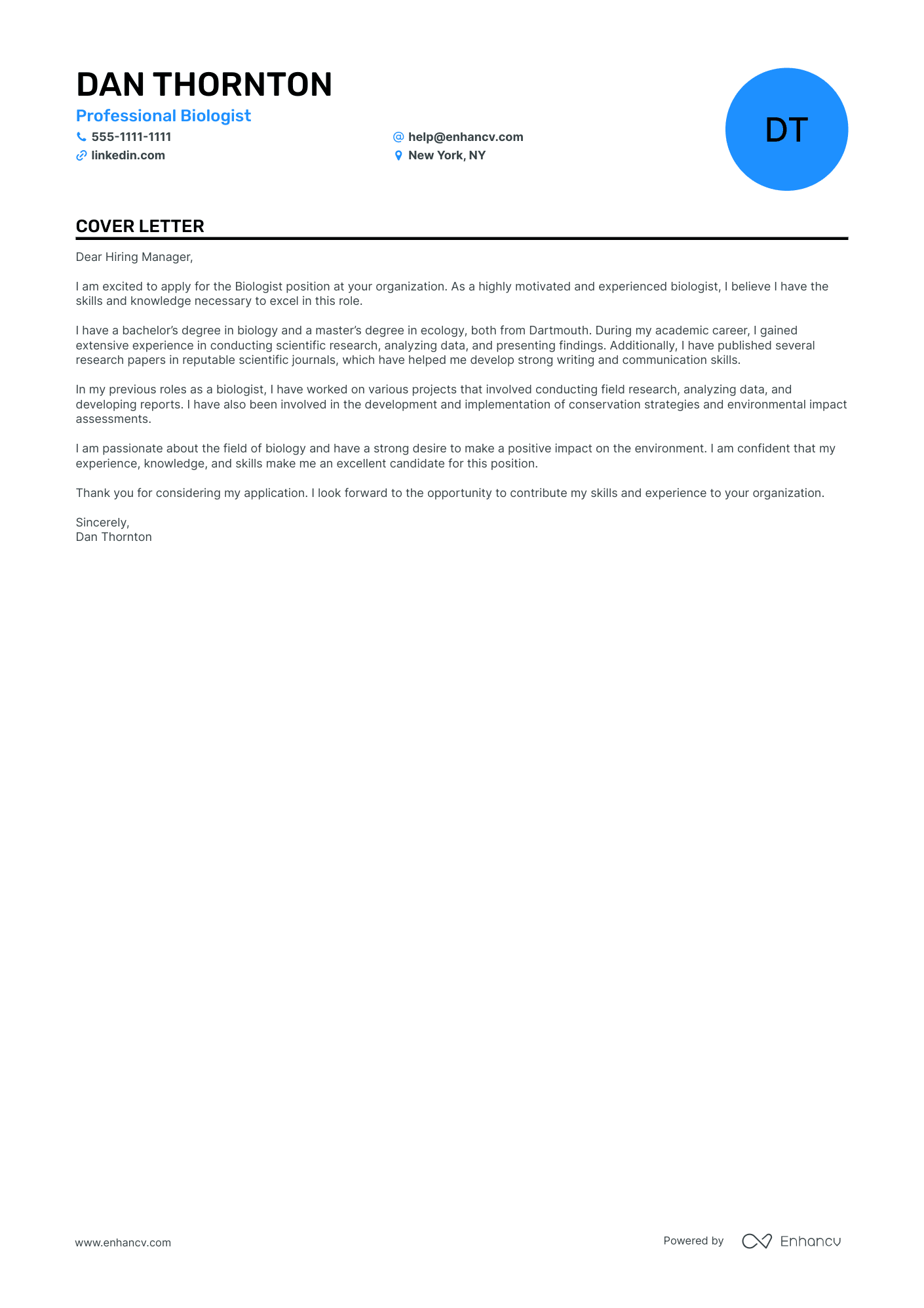You poured years of your life into your passion for scientific research. But sometimes it’s difficult to list all the intangible assets that you bring to the table. Sure, you’ve got tons of research experience, but sometimes you feel like there are so many other applicants who bring that same level of expertise.
Don’t sell yourself short, though. With a quick examination of your skills, abilities, and work history, you can craft a great biology resume that allows you to stand out from the pack.
In this article, you’ll gain the skills to create an eye-catching biologist resume, including a step-by-step guide for each important section of your resume.
Choose the Best Format for Your Biology Resume
At Enhancv, we’ve done a case study where we compared different Microsoft Office resume templates against our own modern resume templates on a multitude of Applicant Tracking System (ATS) software. We found our resumes outperform Microsoft and other templates.
But in order to have your resume make it through ATS sifting, avoid basic mistakes. Below, you’ll find the common mistakes most applicants make with their resumes:
- Length/Columns: Honestly, whether to choose double or single columns doesn’t really matter. Choosing one or two pages for your resume doesn’t matter that much either, but if you can condense your resume to one page with two columns, it can be read easily and effectively.
- Section Headings: With ATS, your section headings need to be easy to read, and it needs to make sense. Your experience section should have only your experience, and the same goes for your education and skills sections.
- Colours and Design: Although ATS systems don’t check for colours, including creative colours and graphics can actually help your resume stand out to recruiters.
- Fonts: Calibri, Ariel, and Times New Roman aren’t your only choices for fonts. In fact, ATS can read all popular Google fonts.
- File Format: PDFs are the go-to for ATS, as they hold together much better than Word documents.
When you’re organizing your resume, use a reverse chronological format, as it shows your most recent experience first.
If you’re entering a new industry or have a wide variety of skills, choose a hybrid resume. In a hybrid resume, skills and experience are given an equal amount of representation on the page.
Consider the local standards – Canadian resumes, for example, may have a different format.
Pro tip
Format your resume for the particular job that you’re applying for. For example, pick a reverse chronological format to highlight your work experience or a hybrid to juxtapose your skills with your work experience.
Add Your Contact Information in the Resume Header
Not only will hiring managers read your contact information in your resume header, but ATS systems actually scan for the information found in it. The contact data on your resume header should match other biology resumes:
Create a Compelling Biology Resume Summary
Resume summaries are like elevator pitches, as they give you a brief space to share about yourself, your skills, and your abilities.
Below, you can find a checklist of the most important things to include in a resume summary:
- Your most recent job title
- Years of experience
- The most relevant skills that you have in your field
- Your top one or two professional achievements
A professional summary can allow a hiring manager to easily see the value you add to their company. Resume summaries are also important for ATS systems because you can include distinct keywords which can help put your resume at the front of the list.
Experienced biology resume summary
Entry-level biology resume summary
Feature a Standout Biology Experience Section
In a STEM field like biology, your experience is your main selling point. When listing your experience, always use quantifiable examples from your career. Below, you can find some tips to create a job-winning biology resume experience section:
- Reverse chronological order: Job seekers benefit from arranging their resume experience section in a reverse chronological format because all your most recent experience is listed first.
- Job title: Always include the job title of your current position. ATS software scours through your resume to find job titles in your keywords.
- Company’s name, location, and description: Include the name and location of the places you worked, as well as a brief description of the company.
- Date of employment: ATS systems have an easier time scanning your resume if you include the month and the year.
- Achievements and responsibilities (focus on how many bullet points and how many jobs are acceptable).
- Include academic experience: Your academic experience, including research projects and data collection, may apply if you’re straight out of college and need to boost your resume.
How to highlight your experience
The major key to filling out your experience section is to find quantifiable goals that you reached. Don’t just say you collected and analyzed data, say that you’ve shown a proven track record of over 60+ DNA cloning tests.
First, sift through all the things that you accomplished in your previous role, and find the experience that highlights your scientific skills. Take a look below to see some examples.
Biology resume experience
- •Handled specimens according to laboratory research protocols, adhering to strict discipline to maximize accurate results.
- •Performed 60+ DNA cloning tests.
- •Used expert verbal and written communication to share data with my team of 10 researchers.
- •Secured a research grant for $25,000 from the National Science Foundation.
List Your Education
In the biology field, your education section may carry almost as much weight as your experience section. If you’ve attended a university with a prestigious reputation, don’t forget to mention the years you attended it.
Below, you’ll find some of the most important things to include in an education section:
- Degree Name
- University, college, or other institution
- Years Attended
- Your thesis or other coursework you completed
- Your Grade Point Average (optional)
- Honors, Dean’s list, or other distinctions (optional)
- Location (optional)
Highlight All Your Biology and Laboratory Skills
Technical skills can take you a long way in the biology field, but all scientists use soft skills to accomplish their goals. Soft skills are commonly referred to as people skills, and applicants who have them have a greater ability to thrive in a team environment.
Skills section checklist
- Take stock of your abilities: Make a list of all the skills you use daily. Leave nothing out, even if you feel like the skills aren’t necessarily applicable.
- Go through your accomplishments and make a list of skills gleaned from them. For example, if you’ve posted in peer-reviewed journals, then mention that your skills include compiling data and creating well-structured, coherent reports.
- Find the skills that are in high demand for your industry: Scour the job description, talk with recruiters, and speak with other colleagues to learn the most in-demand skills in your field.
- Scatter your skills throughout your resume: Include some of your skills not just in your skills section, but in your work experience and resume summary examples.
How to list hard skills
Hard skills are industry-specific skills which are easy to quantify. These are technical skills involving in-depth scientific research.
Listing hard skills on a biologist's resume is important because Applicant Tracking Systems will find major keywords in this section. An impressive biology resume will include skills you’ve picked up from previous positions or during your advanced degree, including DNA extraction.
With technical skills, always include concrete facts and figures to show your expertise in a field. If you’re applying for a position as a wildlife biologist, don’t just list excellent biological research skills. Instead, share that you “Conducted comprehensive studies on future habitat monitoring”.
Top 6 technical skills for biology
- Laboratory techniques
- Excellent Data analysis
- Designing and executing experiments
- An aptitude for fieldwork
- Computer programming
- Scientific Writing
How to list soft skills
Soft skills are equally important to list on a biology resume because your professional experience can only go so far.
A hiring manager wants to know more than just your extensive background in molecular biology. They also want to know how you’ll treat coworkers and research assistants.
Soft skills are also picked up by ATS and could give your resume a better chance of being seen by a hiring manager.
6 most popular soft skills for biology
- Attention to detail
- Analytical thinking
- Communication skills
- Problem-solving skills
- Collaboration skills
- Time management
Include Your Biology Certificates
Including your certifications is important in the biology field because each certification you possess makes you more sought after by employers. Many certifications involve a quick examination by a professional association. It may take time and effort to complete the application process, but it’s well worth your time.
When listing a certification, be sure to include:
- Certification name
- Name of issuer
- Year of obtainment
- Location (if applicable)
- Date of expiration (if applicable)
- Expected date of obtainment (if applicable)
Relevant certifications in the biology field:
- Certified Fisheries Professional (CFP)
- Certified Wildlife Biologist (CWB)
- Certified Ecologist
- American Board of Environmental Professionals (ABEP)
Use Other Relevant Sections to Put the Cherry on Top
Besides the sections listed above, you may wish to include other sections on your resume. In fact, if you’re applying for a managerial role, you may wish to include a “Day of My Life / My Time Section”, like Marissa Mayer included on her resume.
Although ATS may not read other sections, that doesn’t mean that it will affect your chances of being hired. If anything, when your resume is finally in the hands of a hiring manager, they’ll be able to better understand your previous experience.
Here are some relevant sections you may wish to include:
- Membership of professional associations: Possessing credentials from the right professional associations may give you a leg up in your job search. Some employers are looking for candidates who specifically have the backing of a governing body.
- Publications: Include the most important peer review journal articles you’ve written. This is especially true for research studies that have gained a wide audience and helped to provide you with credibility.
- Conferences: List major conferences you’ve attended, especially if you had a role in presenting research papers at them.
- Language skills: Having the ability to read and speak another language may give you a better chance of being hired. Since new discoveries in biology are being done throughout the world, having the ability to read other languages shows you can stay at the cutting edge of scientific research.
Create a Matching Cover Letter for Your Biology Resume
A cover letter is tailored to a specific hiring manager and written to show how your skills and ability match up to the job ad that they posted.
Here’s what you should include in your cover letter:
- Contact information that corresponds with the resume.
- Greetings.
- Achievements in the first paragraph.
- Cover letter body:
- Work experience
- Skills
- Why you’d be a good fit
- Call to action
biology cover letter examples:
Template
Dear [Hiring Manager],
I am excited to apply for the Biologist position at [Company Name]. As a highly skilled biologist with [number of years] of experience in the field, I am confident in my ability to make meaningful contributions to your team.
In my current role at [Current Company], I have gained extensive experience in [insert relevant experience, such as field research, laboratory techniques, data analysis, etc.]. I have also been responsible for [insert additional responsibilities or achievements that show your expertise].
I hold a [degree level] in [Biology-related field] from [University], where I gained a firm foundation in [insert relevant coursework, such as genetics, ecology, molecular biology, etc.]. I am also proficient in [list any additional skills or tools, such as statistical software, DNA sequencing, etc.].
What sets me apart as a biologist is my passion for [insert specific area of interest, such as conservation, biotechnology, wildlife management, etc.]. I am driven by the desire to make a positive impact in this field, and I am always eager to learn and explore new opportunities.
I am excited about the prospect of joining [Company Name] and contributing to your mission. Thank you for considering my application. I look forward to discussing my qualifications further.
Sincerely,
[Your Name]
Interested in learning more about how to craft the perfect cover letter? Check out these blog posts on the Enhancv blog:
Key Thoughts
- You may use different resume formats for unique positions.
- Did you know that your resume header will be scanned by ATS?
- Your resume summary is your elevator pitch, your moment to share who you are.
- Always quantify your experience, giving real, tangible numbers to your tasks.
- Hard and soft skills are both needed on a biology resume.
- Share papers presented at conferences in a separate section.
- Use your cover letter to provide a great opportunity to share why you’d be a good fit at a company.
